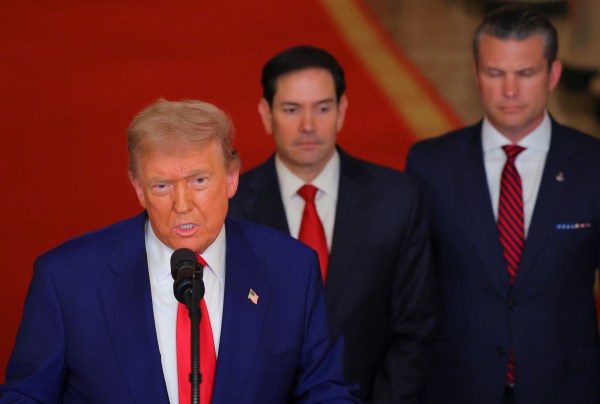What has come over the Biden administration?
Back in late February, shortly after Russia invaded Ukraine, when Vladimir Putin put his nuclear forces into “special combat readiness,” President Joe Biden hopped on the hotline to Moscow to urge de-escalation. When the idea of a no-fly zone over Ukraine first arose, White House spokeswoman Jen Psaki described U.S. policy as “prevent[ing] world war here.” Biden repeated his concerns about “World War III” four times in two separate appearances. MiG-29 fighters from Poland to Ukraine? “We do not support the transfer of the fighters to the Ukrainian air force at this time,” explained Pentagon spokesman John Kirby in early March.
Now in late April times have apparently changed, caution thrown to the wind, imminent nuclear Armageddon discounted. Avoiding escalation is no longer the strategy. After visiting Kyiv and talking to Ukrainian President Volodymyr Zelensky, Secretary of Defense Lloyd Austin and Secretary of State Antony Blinken briefed the press on the results. “We want to see Russia weakened to the degree that it can’t do the kinds of things that it has done in invading Ukraine,” Austin declared. “And”—a little less lucidly—“we want to see them not have the capability to very quickly reproduce that capability.” Blinken, normally the definition of diplomatic discretion, chimed in: “Russia has sought as its principal aim to totally subjugate Ukraine, to take away its sovereignty, to take away its independence—that has failed. It has sought to assert the power of its military and its economy. We, of course, are seeing just the opposite, a military that is dramatically underperforming and an economy … as a result of sanctions that is in shambles.”
It should be said that the administration made some of the right moves in the early days of the war: heavy sanctions, hundreds of millions of dollars in weapons, including anti-tank and anti-aircraft missiles. But its public statements about what it wouldn’t do sent a message to Putin about what he could get away with. Now, however, beyond the improved rhetoric, the administration has begun to develop a coherent strategy and organize a coalition for actively repelling the Russians. The flow of heavier weapons has begun, and even the reluctant Germans were among the contributors at a “donors conference” of 40 nations just held at Ramstein Air Base. The White House also named retired Army Lt. Gen. Terry Wolff, former director of strategic plans for the Joint Staff and deputy commander of U.S. Army Europe, to coordinate arms transfers both within the United States and across the alliance to Ukraine. The administration is providing current-generation weapons to replace those Soviet-era systems that ex-Warsaw Pact countries are sending to Kyiv, including 300 modern M1 Abrams tanks to Poland. This has emboldened other NATO countries to do likewise; again, even the Germans are deploying Patriot air and missile defense batteries to Slovakia, which has donated its Russian-made S-300 missiles and launchers to Ukraine.
To be sure, a good part of any explanation for this seeming change must be the result of Zelensky’s extraordinary leadership, the success of Ukrainian troops in defeating the Russians before Kyiv and Kharkiv and on the road to Odesa, and the heroic resistance in Mariupol. The power of Ukraine’s example is contagious. Washington now shows symptoms of the leadership virus. For an administration whose martial reputation was at a nadir after the shameful retreat from Kabul only months ago, the work of reclaiming the mantle of “leader of the free world” may at least have begun. America isn’t exactly “back” in the way Biden once boasted. But, as George Kennan once lamented, America is “slow to wrath—in fact, you have to whack his tail off to make him aware that his interests are being disturbed; but, once he grasps this he lays about him with … blind determination.”
Yet it is too early to tell whether the Biden administration has cast off its cosmopolitan appendage to be guided by this core American reptilian brain. The president and his senior advisers have heretofore avowed their faith in “smart power” in contrast to hard, military power that is the traditional ultima ratio regum—as well as the lingua franca of history’s autocrats.
When it comes to the larger and longer-term measures of policy and strategy—the formal national security and defense strategy documents required by law and the annual defense budget request and five-year plan—signs of revived American engagement are harder to come by. To be fair, the bureaucratic processes for all of these were all but complete when the Ukraine war began, and the overarching national security strategy, which is meant to be the comprehensive guide to all agencies of the government, has yet to be released. But the line coming out of the administration—and especially the Pentagon—has been that the “acute” threat from Russia was already well understood and factored into the equation.
Let’s begin with what we do know. Even more than formal strategy statements, it is budgets that reveal a government’s priorities: as President Biden often says—supposedly quoting his father—“Show me your budget and I’ll tell you what you value.” By that standard, and understanding “budget” to be all the ways in which the government spends money, military power is very low among Biden’s priorities. The official federal budget is allocated into three main categories: “discretionary” spending, for which Congress must vote appropriations; “mandatory” spending, for entitlement programs that do not require specific congressional approval; and interest on the national debt, which is another form of must-spend money. The White House request for fiscal year 2023 is for nearly $5.7 trillion; of that, $3.7 trillion is for mandatory programs and another $400 billion for debt service, although that amount is based on a level of inflation estimated at just 4.7 percent when it is more likely to end up at 7 percent, according to the reckoning of private financial institutions. Let’s say that, before Congress casts a single vote, the federal government is on the hook for about $4.2 trillion.
Of the $1.7 trillion request for discretionary programs, total defense (including the national nuclear infrastructure and other efforts outside the military) accounts for $795 billion and “non-defense,” domestic discretionary program for $928 billion. So, of “normal” business (that is, not counting things like COVID relief or supplemental infrastructure outlays, let alone any “Build Back Better” bills), all defense spending consumes less than 14 percent of what the government plans to spend; the “Pentagon accounts for 3.4 percent of estimated gross domestic product. Through the long Cold War, U.S. defense spending averaged about 6 percent of GDP. The Biden budget marks the start of the fifth decade of the post-Cold War “peace dividend.” Given that the formal estimate of defense inflation is just 2.3 percent, the Pentagon’s actual purchasing power will decline markedly with an inflation rate of 7 percent.
After decades of disinvestment, the armed forces need all the purchasing power they can get. Alas, the backbones of the services, the weaponry of the Reagan build-up of the 1980s, is increasingly fragile and there are few replacements to be had immediately. The U.S. Air Force operates eight aircraft fleets whose average age is greater than 50 years, and the service will have to mothball 1,500 aircraft over the course of the Biden defense program, with only a small fraction of new replacements. The Navy is retiring some of its most recent purchases of littoral combat ships—smaller surface ships designed for near-shore operations—as the fleet shrinks toward about 280 ships. The global patrols of the past demanded that the Navy keep anywhere from 130 to 150 ships at sea at any one moment—a level of operations far beyond what it can do now. In response to the Ukraine war, the Biden administration has deployed three heavily armored brigades to Eastern Europe; that’s one-third of the Army’s total heavy force and a level of rotational effort the service cannot long sustain.
With its formal defense strategy, meant to give guidance to the military services and provide justification for the defense program, Biden administration has tried to transform these many bugs into features of a new system of “integrated deterrence.” A full, classified version of the strategy was sent to Congress at the end of March, and the administration has promised to put out a public version in short order. But two-page “fact sheet” released by the Pentagon is laden with obfuscating jargon of this sort. Integrated deterrence “entails developing and combining our strengths to maximum effect, by working seamlessly across warfighting domains, theaters, the spectrum of conflict, other instruments of U.S. national power.” This sounds awesome, if opaque. Indeed, the smart-power set have long idolized a nifty “whole of government” approach in contrast to just killing bad guys, breaking things and other less clever, if more traditional, pursuits.
If “integrated deterrence” is the end of defense strategy, something called “campaigning” is the means by which this is to be accomplished. Unlike simple “attacking” or “defending” or other things that military forces uniquely do, this pushes the all-agencies model down to what has heretofore been thought of as the operational level of conflict. And, as the product of a decidedly Democratic administration, American armed forces must be alert to “changes in global climate and other dangerous transboundary threats.”
If this kind of talk seems a little conceptual in the context of Ukraine’s war for its own survival, its hopes for freedom and a Russian threat that’s all about boundaries, well…that’s because it is; the lack of precision and urgency are hard to miss. And further, if past is prologue, it is a near certainty that the overarching national security strategy will be even more gaseous than the Pentagon’s version. These documents, throughout the post-Cold War era, served to expand—and thus to dilute—the meaning of “security.”
This would be a truly unfortunate time to miss the opportunity and the real lessons of the Ukraine moment for America and its allies, lessons about the nature of geopolitics and what it means to be a global, ordering power. The first reminder is that the world is a hard, Hobbesian place, requiring the exercise of hard—meaning military and economic—power to preserve liberty and foster prosperity. The second reminder is that the liberal world the United States and its partners have made is a system requiring favorable balances of power in the major theaters of international competition: in Europe, in maritime East Asia, and the greater Middle East. Shortchanging any of these—which we have done regularly for decades—puts the whole thing at risk. The Biden administration must resist the temptation to “prioritize” the “pacing threat” posed by China to an exclusive degree.
Which is the real Biden administration: the “war-winners” of late or the “conflict resolvers” they’ve been before? Can they lay about America’s adversaries with blind determination?
Giselle Donnelly is a senior fellow in foreign and defense policy studies at the American Enterprise Institute.






Please note that we at The Dispatch hold ourselves, our work, and our commenters to a higher standard than other places on the internet. We welcome comments that foster genuine debate or discussion—including comments critical of us or our work—but responses that include ad hominem attacks on fellow Dispatch members or are intended to stoke fear and anger may be moderated.
With your membership, you only have the ability to comment on The Morning Dispatch articles. Consider upgrading to join the conversation everywhere.